Port is the most recognizable name in fortified dessert wines. Hailing from the Douro River Valley in northwest Portugal, Port was created in the 18th century by the British who experimented with adding brandy to still red wines, fortifying them in an effort to stabilize them for the extended voyage across the Bay of Biscay and up the coast of France to England.
Today, you can find Port wine in a range of versatile styles including ruby, tawny, white, and rosé. Most Port has a semi-sweet to notably sweet taste profile and for this reason, Port has a reputation as a popular dessert wine. The sweetness in the wine comes from the brandy that is added during fermentation, which halts the fermentation process, leaving some sugar behind and increasing alcohol levels to up 20% ABV.
Traditional Port Grapes
Built on the blended synergy of Portugal’s indigenous red grapes, most of the region’s Port production is focused on Touriga Nacional, Touriga Franca, Tinta Roriz (aka Tempranillo), Tinta Barroca, and Tinto Cão.
Spirits Used To Fortify Port
When visiting the IVDP (Instituto dos Vinhos do Douro e Porto) we learned that the brandy used in Port winemaking is a neutral (flavorless) grape spirit sourced primarily from Portugal, Spain and France.
Port Styles and Wine Pairings
Ruby Port
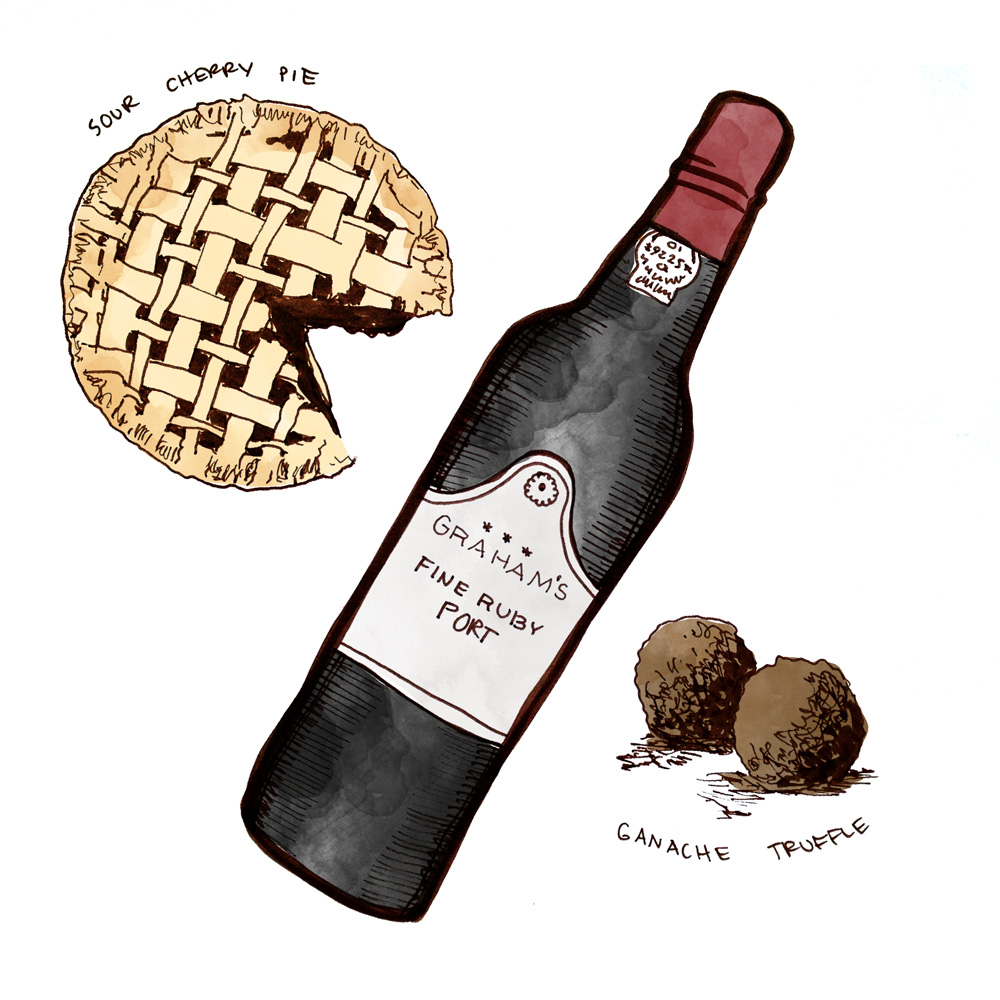
Showing a simple, fruity, youthful character, Ruby Ports are generally the least expensive of the Port wines available on the shelf. Typically aged in large oak casks for an average of two years, Ruby Ports are ready to drink as soon as they’re bottled.
- Color: Ruby red
- Flavor: A remarkable medley of ripe red and black berry flavors, with plums, and dates, exhibiting some concentration and depth. Fresh-faced and youthful, Ruby Port delivers lip-smacking sweetness with subtle tannin.
- Serving Tips: Ruby Port is intended to be consumed young and promises to dazzle with fresh, happy, primary fruit on both the nose and palate. This particular style of Port is a blend of good quality red grapes from a variety of vintages and has likely only seen a few years of wood aging prior to release. Serve slightly chilled (around 55-65°F). The bottle should feel cool to the touch. Ruby Port will keep for several weeks after opening if it is stored in the fridge.
Ruby Port Pairing
Given its fresh-faced nature, raspberry and black cherry flavors, rich textures, and sweeter style, Ruby Ports echo a duo of classic desserts: sour cherry pie and chocolate ganache truffles. Pair a glass of Ruby Port with a stinky blue cheese and your taste buds will tumble into a spectacular yin and yang balance of sweet and savory notes.
- “Aha” Pairing: Graham’s Six Grapes Reserve Port with Bourbon Chocolate Chip Pie
Late-Bottled Vintage (LBV) Port
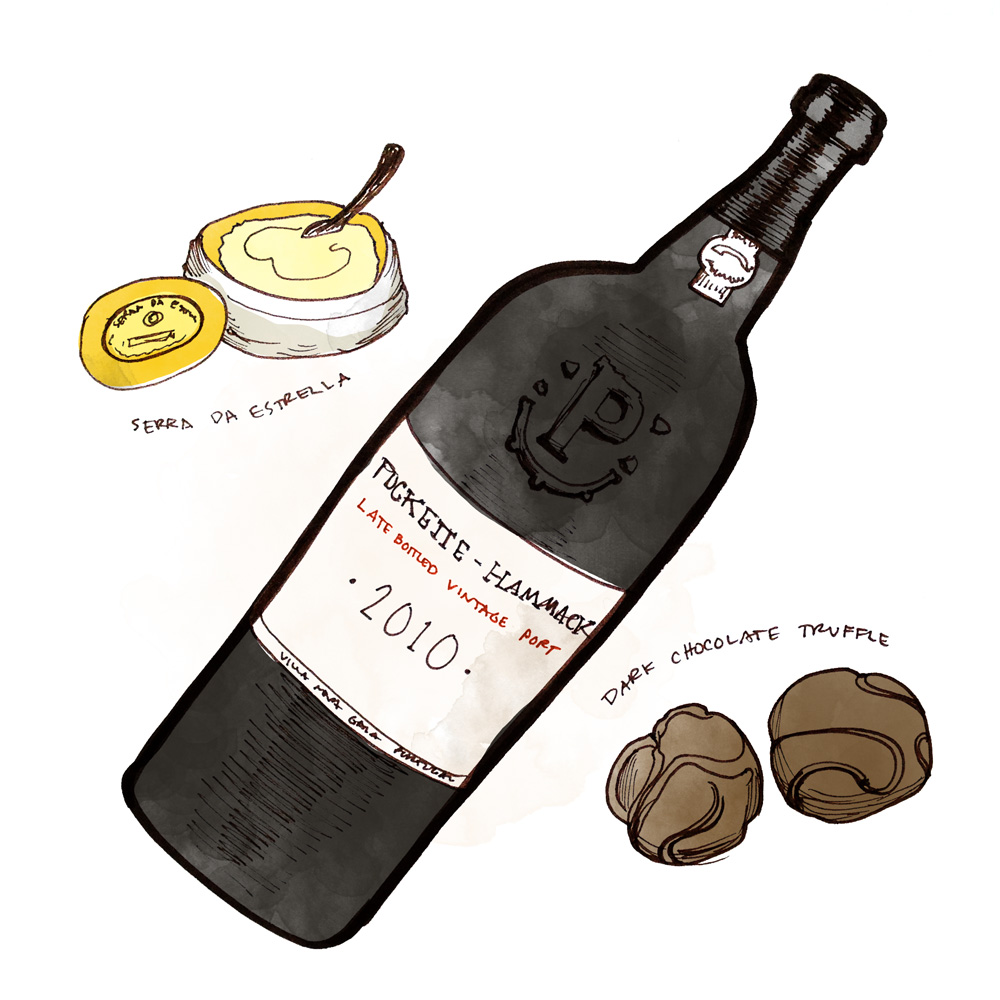
As the name implies, LBV Port is developed from a single-vintage Ruby Port and may enjoy up to six years in the barrel before being bottled and released.
- Color: Purple, ruby red
- Flavor: LBVs are sweet in style, with moderate acidity and tighter tannins. Expect black currants, cherry, chocolate and jammy influences to grab your attention with every sip. Dried fruit flavors (particularly prunes and raisins) mingle with an earthy/ leathery aspect, leading into floral themes and ending on an almond meets walnut backdrop.
- Serving Tips: LBV is ready to be enjoyed as soon as you can open the bottle. Serve slightly chilled (shoot for 55-65°F). LBV Ports are capable of keeping for a few weeks after opening if kept refrigerated.
LBV Port Pairing
Spend a day living like the Portuguese locals and you’re bound to come face-to-face with Queijo da Serra, a vibrant, tangy, mild cheese made in the Serra de Estrela (“Star Mountain Range”) in Portugal. Crafted with sheep’s milk, the coagulating properties of the spiky purple Cardoon flower, and sea salt, this is the epitome of a regional pairing (local foods with local wines). The savory draw of aged Parmesan and the classic Stilton also cry out for the unctuous, sweet notes of a traditional LBV. Have a chocolate addict on your hands? LBV is there for you too. Heavy, rich, and dark, not unlike a slab of dark chocolate itself, this wine shows unabashed favoritism to all things chocolate. German chocolate cake, homemade chocolate sauce, molten chocolate lava cake, chocolate bread pudding and the like all claim some serious time in the LBV limelight.
- “Aha” Pairing: Taylor Fladgate Late-Bottled Vintage Port 2010 with Flourless Chocolate Cake and Fresh Raspberry Sauce
Vintage Port

The crème de la crème of Port offerings, Vintage Port is made with top-quality grapes selected from a single vintage. When it comes to this coveted treat, quality can cost some serious cash as bottles range from an affordable $30 to well over $200, depending on the producer and vintage.
- Color: Dark purple to ruby red (there’s a theme here)
- Flavor: Full-bodied, semi-sweet to notably sweet with concentrated blackberry, black cherry, and ripe raspberry alongside warm pumpkin pie spice, chocolate, and coffee with fig and smoky nuances.
- Serving Tips: Vintage Ports are Ruby Ports built for bottle aging. These wines have short maturity times (18-36 months) before bottling and forgo any fining or filtration. Therefore, you can expect these delicious fortified wine divas to develop some serious sediment over the years, making decanting a must for most bottles. Serve at “cellar temperature” (around 65°F).
- Good Vintages: 2011, 2009, 2007, 2003, 2000, 1997, 1994, 1985, 1983, 1980, 1977, 1970. See old vintage list here.
Vintage Port Pairing
One of the beauties of Vintage Port is that the high-strung, abrasive tannins of youth will soften and mellow over time (…a long time: think decades). Happily, these older bottles remain full-bodied and range from sweet to semi-sweet in terms of residual sugar, while showing lower levels of innate acidity.
The endearing characteristics that highlight a classic Vintage Port pairing involve buttery and tangy elements, ok… and probably the crazy stink of Stilton blue cheese. Dubbed by many as the “perfect pairing” and completely counterintuitive by most standards, you can easily substitute, Roquefort, Cashel Blue, the famous French Bleu d’Auvergne, or Gorgonzola to marry the rich, silky textures of a Vintage Port with the bold, snappy stench of odiferous blue cheese. As the classic sipping wine, Vintage Port is an excellent accompaniment for small plates that feature ingredients such as blue cheese, dark chocolate, figs, and walnuts (which add their own tannic tango to the mix).
- “Aha” Pairing: Churchill’s Vintage Port 2003 with Royal Blue Stilton Cheese by Long Clawson Dairy
Tawny Port
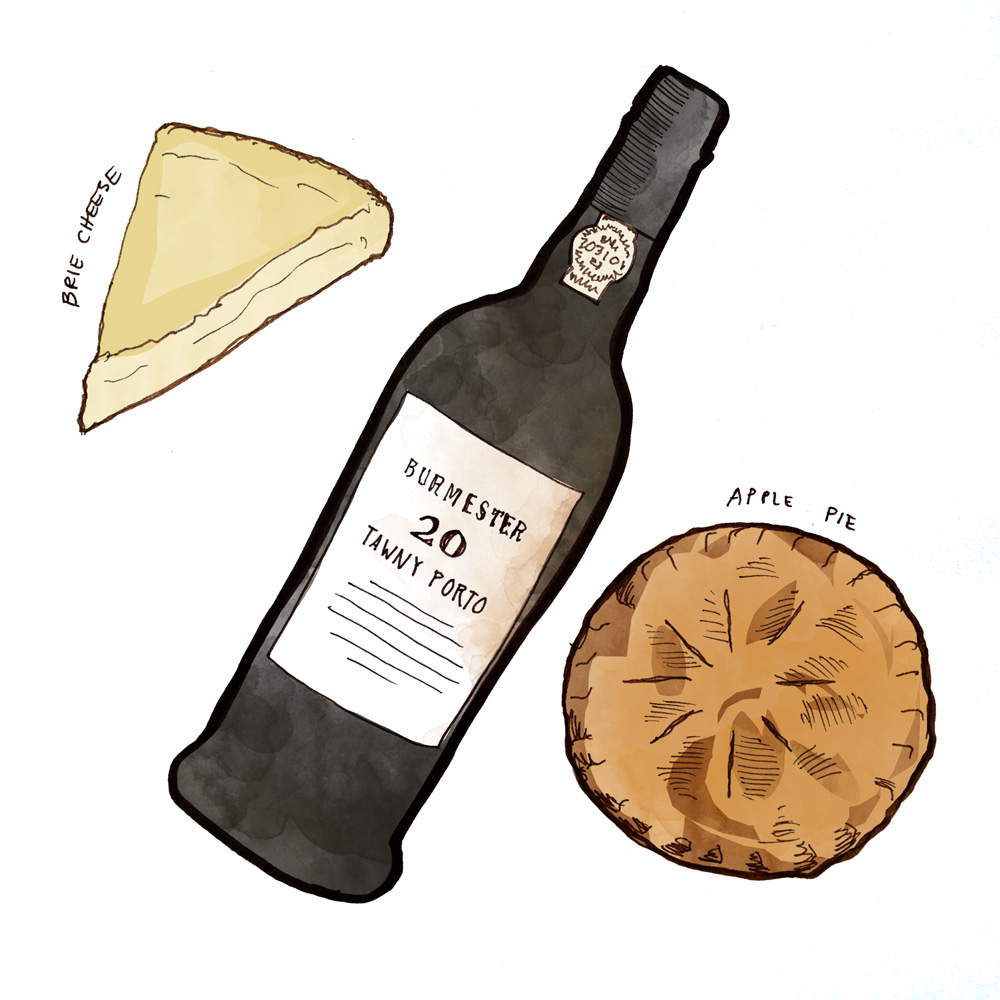
Complex and concentrated, Tawny Ports aren’t nearly as fresh and fruity as their Ruby Port cousins (after all, they’ve had to age a minimum of seven years in oak). More reserved, sometimes serious, and often sweet, Tawny Ports have rich, smooth lines that support the yummy oxidized flavor profiles of age-designated bottles.
- Color: Pale, brown to golden… well “tawny” in color (thanks to oxidized aging)
- Flavor: This wine has a nutty, caramelized character that often delivers buttered toffee and smoky vanilla themes in tandem with blackberry, ripe cherry, and crème brûlée alongside dried orange, sweet figs, and mocha notes with some age-designated bottles carrying the unmistakable aromas of spiced candied pecans or sticky toffee pudding (a classic English dish).
- Serving Tips: Most Tawny Ports have an age designation on the label: 10, 20, 30 or more years, which indicates the average year of the grapes in the bottle, not the vintage age of the fruit harvest. Tawnies don’t throw sediment and can typically skip the decanter. Because of the innate oxidation, they can easily last a month once opened (store in fridge). Serve cool (around 55-60°F).
Tawny Port Pairing
With their sweet to semi-sweet character, nutty nuances, dried apricots, and spiced toffee aromatics, Tawny Ports are a natural pairing for all sorts of nutty delights. Think pecan pie, almond biscotti, or regionally-inspired Portuguese salted almond cake, or caramel covered cheesecake. This wine is also exceptional at bringing out the best in German Chocolate Cake, cinnamon-crusted apple pie, crème brûlée, and can even complement the fluffy, full-throttle flavors of coconut cream pie. While handling all sorts of sugar themes with ease and delicious determination, Tawnies are completely capable of partnering up with the savory side of smoked cheddar, Pecorino, and aged Manchego (yum!).
- “Aha” Pairing: Graham’s 20-Year-Old Tawny with classic French crème brûlée
White Port
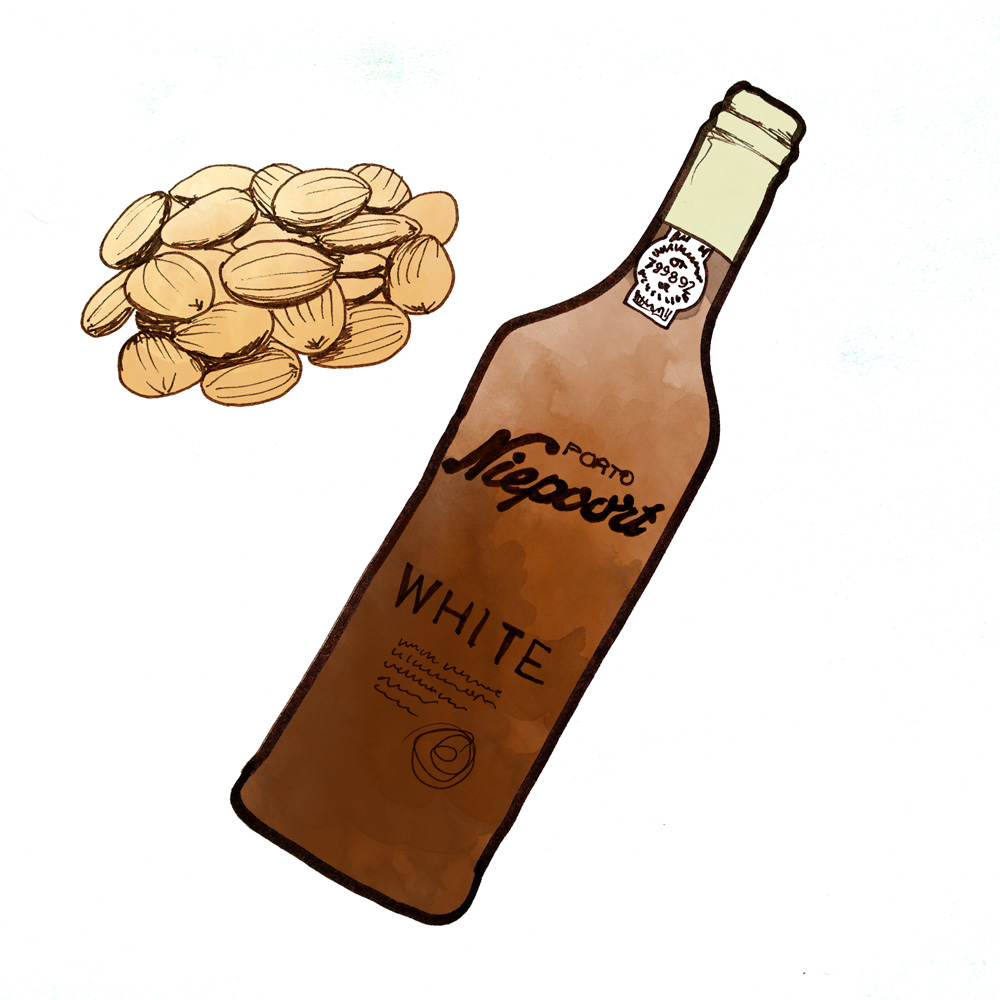
Often crafted from a “field blend” of indigenous white grapes that include the likes of Códega, Malvasia Fina, Esgana Cão, Gouveio, Rabigato, and Verdelho, White Port shines as a refreshing fortified wine that typically carries 18-20% alcohol.
- Color: Golden, amber, and sometimes carrying pinker hues
- Flavor: Expect citrus and stone fruit to carry over into the glass and Port’s trademark nutty, raisin, and spice influences will surface front and center. Honeyed character reveals a rich, smooth texture that is most often made in a dry to off-dry (and occasionally sweet) format.
- Serving Tips: Don’t decant. White Port is ready to pour as soon as the bottle is open. Serve slightly chilled (ideally 45-50°F).
White Port Pairing
White Port often finds itself chilled and flying solo in a white wine or traditional port glass, playing the part of the willing aperitif. However, it is just as often dressed up with equal parts Port to tonic and garnished with a slice of lemon. Often served as an aperitif with the unforgettable large, blanched, and slightly salted almonds of the Douro, White Port is a versatile pairing partner. Drier styles of White Port shine brightly with everything from smoked salmon, shellfish, and sushi. It also works well alongside a tray of Gruyere, olives, and charcuterie. Prefer a sweeter style of White Port? Then, partner up with fresh fruit themes: angel cake with strawberries, lemon meringue, peaches in cream, or white chocolate covered strawberries.
- “Aha” Pairing: Churchill’s Dry White Port with Smoked Salmon Crostini
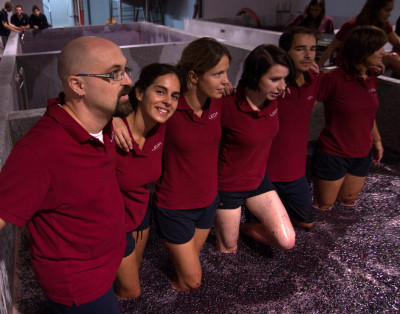
See How Port is Made
The basics on how Port wine is made including pictures from the Douro Valley region.
Port Wine 101